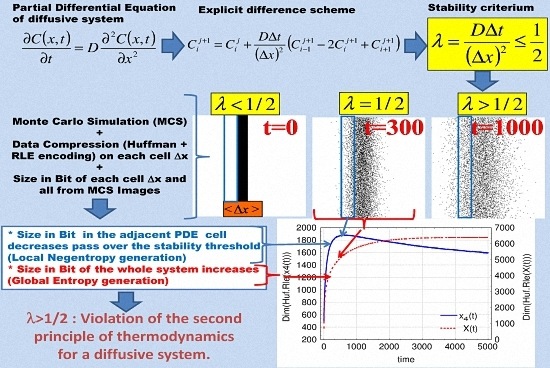Analyses of the Instabilities in the Discretized Diffusion Equations via Information Theory
Abstract
:1. Introduction
2. Diffusion Equations
2.1. Parabolic Differential Equations
2.2. Stability Study
2.3. Monte Carlo Simulation
3. Quantitative Description of the System in the Area of the Information Theory
3.1. Mathematical Formalism
3.2. The Different Classes of Algebra
4. Results
4.1. Compression Data Analyses
4.2. The Relation between Stability Criteria and the Dimension of Reduced Space
5. Two Examples of PDE
5.1. Non Constant Diffusion Coefficient
5.2. Nonlinear PDE
6. Discussion
7. Conclusions
Author Contributions
Conflicts of Interest
References
- Dautray, R.; Lions, J.-L. Analyse Mathématique et Calcul Numérique pour les Sciences et les Techniques. Volume 1: Modèles Physiques; Masson: Paris, France, 1987. (In French) [Google Scholar]
- Dautray, R.; Lions, J.-L. Analyse Mathématique et Calcul Numérique pour les Sciences et les Techniques. Volume 7: Evolution, Fourier, Laplace; Masson: Paris, France, 1988. (In French) [Google Scholar]
- Dautray, R.; Lions, J.-L. Analyse Mathématique et Calcul Numérique pour les Sciences et les Techniques. Tome 9: Evolution, Numérique, Transport; Masson: Paris, France, 1997. (In French) [Google Scholar]
- Forsythe, G.E.; Wasow, W.R. Finite Difference Methods for Partial Differential Equations; Wiley: New York, NY, USA, 1960. [Google Scholar]
- Brillouin, L. Science and Information Theory; Academic Press: New York, NY, USA, 1956. [Google Scholar]
- Delahaye, J.P. Information, Complexité Hasard; Hermès: Paris, France, 1994. (In French) [Google Scholar]
- Chaitin, G.J. Algorithmic Information Theory; Cambridge University Press: Cambridge, UK, 1887. [Google Scholar]
- Bigerelle, M.; Iost, A. Relations entre l’entropie physique, le codage de l’information et l’énergie de simulation. Can. J. Phys. 2007, 85, 1381–1394. (In French) [Google Scholar] [CrossRef]
- Adda, Y.; Philibert, J. La Diffusion Dans les Solides, Tome II; Presses Universitaires de France: Paris, France, 1966. [Google Scholar]
- Peitgen, H.O.; Jürgens, H.; Saupe, D. Chaos and Fractals: New Frontiers of Science; Springer: New York, NY, USA, 1992. [Google Scholar]
- Feferman, J.W. Kurt Gödel Collected Works. Volume 1: Publications, 1929–1936; Oxford University Press: Oxford, UK, 1986. [Google Scholar]
- Salomon, D. Data Compression; Springer: New York, NY, USA, 1998. [Google Scholar]
- Huffman, D. A method for the construction of minimum redundancy codes. Proc. IRE 1952, 40, 1098–1101. [Google Scholar] [CrossRef]
- Bigerelle, M.; Iost, A. Relationship between information reduction and the equilibrium state description. Comput. Mater. Sci. 2002, 24, 133–138. [Google Scholar] [CrossRef]
- Einstein, A. Investigation on the Theory of Brownian Motion; Dover Publications: New York, NY, USA, 1956. [Google Scholar]
- Bigerelle, M.; Iost, A. Physical interpretation of the numerical instabilities in diffusion equations via statistical thermodynamics. Int. J. Nonlinear Sci. Numer. Simul. 2004, 5, 121–134. [Google Scholar] [CrossRef]
- Lee, C.F. On the solution of some diffusion equations with concentration-dependent diffusion coefficients—II. IMA J. Appl. Math. 1972, 10, 129–133. [Google Scholar] [CrossRef]
- Wagner, C. Diffusion processes during the uptake of excess calcium by calcium fluoride. J. Phys. Chem. Solids 1968, 29, 1925–1930. [Google Scholar] [CrossRef]
- Mishra, S.; Veerappa Gowda, G.D. Optimal entropy solutions for conservation laws with discontinuous flux-functions. J. Hyperbolic Differ. Equ. 2005, 2, 783–837. [Google Scholar]
- Mishra, S. Numerical Methods for Conservation Laws and Related Equations. Available online: https://www2.math.ethz.ch/education/bachelor/lectures/fs2013/math/nhdgl/numcl_notes_HOMEPAGE.pdf (accessed on 14 April 2016).
- Tadmor, E. Entropy stability theory for difference approximations of nonlinear conservation laws and related time-dependent problems. Acta Numer. 2003, 12, 451–512. [Google Scholar] [CrossRef]
- Carrillo, J.A.; Jüngel, A.; Markowich, P.A.; Toscani, G.; Unterreiter, A. Entropy dissipation methods for degenerate parabolic problems and generalized sobolev inequalities. Monatshefte für Mathematik 2001, 133, 1–82. [Google Scholar] [CrossRef]
- Lefloch, P.G.; Mercier, J.M.; Rohde, C. Fully discrete, entropy conservative schemes of arbitrary order. SIAM J. Numer. Anal. 2002, 40, 1968–1992. [Google Scholar] [CrossRef]
- Noble, P.; Vila, J.P. Stability theory for difference approximations of some dispersive shallow water equations and application to thin film flows. 2013; arXiv:1304.3805. [Google Scholar]
- Jaroszkiewicz, G. Principles of Discrete Time Mechanics; Cambridge University Press: Cambridge, UK, 2014. [Google Scholar]













© 2016 by the authors; licensee MDPI, Basel, Switzerland. This article is an open access article distributed under the terms and conditions of the Creative Commons Attribution (CC-BY) license (http://creativecommons.org/licenses/by/4.0/).
Share and Cite
Bigerelle, M.; Naceur, H.; Iost, A. Analyses of the Instabilities in the Discretized Diffusion Equations via Information Theory. Entropy 2016, 18, 155. https://0-doi-org.brum.beds.ac.uk/10.3390/e18040155
Bigerelle M, Naceur H, Iost A. Analyses of the Instabilities in the Discretized Diffusion Equations via Information Theory. Entropy. 2016; 18(4):155. https://0-doi-org.brum.beds.ac.uk/10.3390/e18040155
Chicago/Turabian StyleBigerelle, Maxence, Hakim Naceur, and Alain Iost. 2016. "Analyses of the Instabilities in the Discretized Diffusion Equations via Information Theory" Entropy 18, no. 4: 155. https://0-doi-org.brum.beds.ac.uk/10.3390/e18040155






